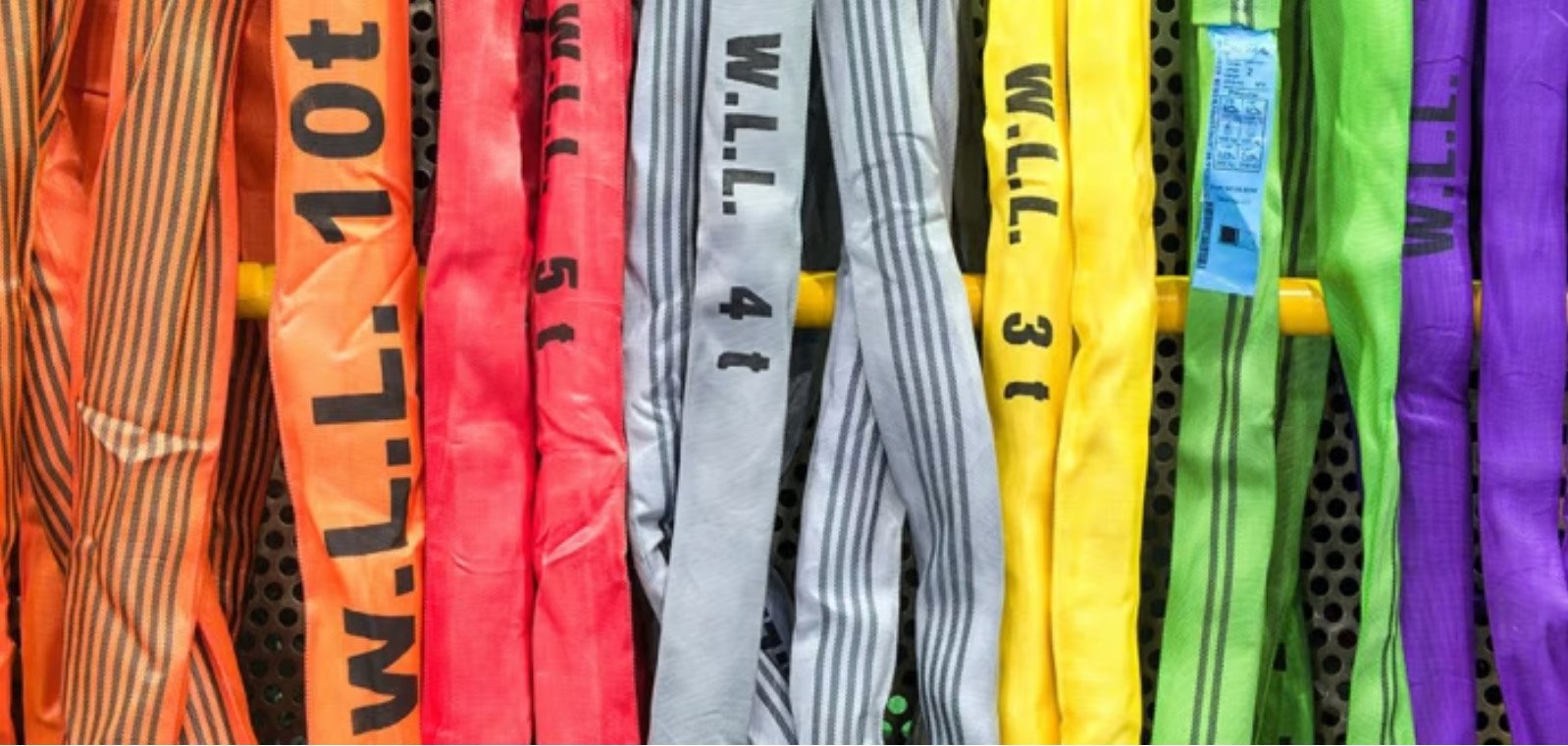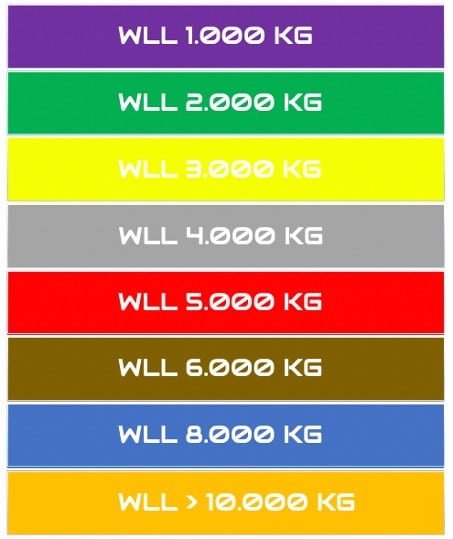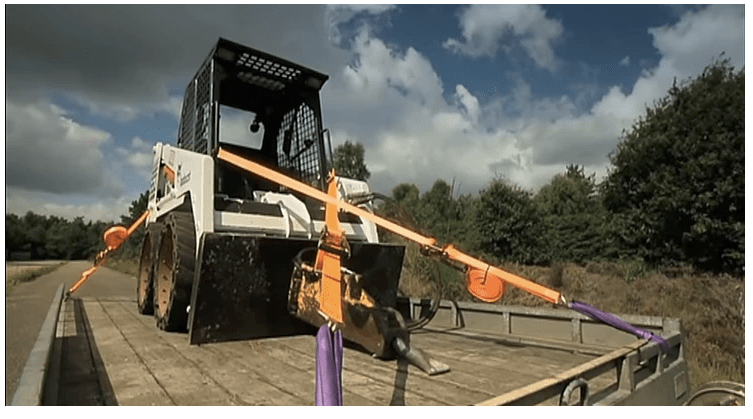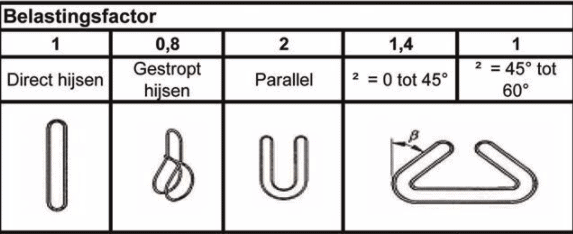How to use webbing slings and round slings to restrain loads?

What are webbing slings and round slings?
As indicated, webbing slings and round slings can be used to lift and restrain loads. The difference between flat webbing slings and round slings is that the latter look like tubular loops. Polyester slings have many advantages over their metal alternatives, such as chains. They weigh less and take up less space, for instance, as well as being easier to maintain and inspect, less dangerous to use, corrosion-resistant and considerably cheaper. Keep in mind that you should always use high-quality, certified polyester round slings that are suitable for professional use.
European standards for lifting equipment
The Machinery Directive 2006/42/EC lays down the requirements that all lifting equipment in Europe must comply with, such as that all lifting equipment must have CE marking. This well-known logo indicates that the product complies with European rules and regulations. Webbing slings must comply with the NEN-EN1492-1:2000 + A1:2008 standard, whereas round slings have to comply with the DIN EN 1492-2:2000 + A1:2008 standard.
Safety factor lifting equipments
All lifting equipment has a safety factor consisting of two digits, with 7:1 and 5:1 being the most common. The minimum breaking load of a sling with a 7:1 safety factor is seven times higher than the load indicated on the sling. In other words, a round sling rated at 2 tonnes should not break until it is subjected to a load of 14 tonnes. Lifting equipment with a 4:1 or 5:1 safety factor is considered so-called one-way lifting equipment, which means it can only be used once before being discarded: once for loading and once for unloading.
Sling colours
You can tell the work load limit of a particular webbing sling or round sling by looking at its colour. This colour-coding system is used worldwide, but it is important to remember that it is not used on all slings. That’s why it’s always important to check the WLL (Work Load Limit) specified on the label, which always takes precedence over the colour of the sling. The colour of the label also indicates the material the sling consists of, with Polyamide (PA) slings featuring a green label, Polyester (PES) slings featuring a blue label and Polypropylene (PP) slings featuring a brown label.

Round slings as artificial anchor points
Round slings are used to hold loads in place in the absence of lashing rings. When lashing loads in the direction of travel, round slings can be tied around the load and fixed in place with lashing straps. There is little information available about restraining loads with round slings, which is why I’ll explain how it works in greater detail below.

Maximum loads for round slings
In the past, people assumed that the safety factor of a round sling used to secure a load was the same as for any sling used to secure a load. As soon as a round sling was subjected to loads exceeding its WLL (Work Load Limit), it was immediately considered unsuitable for lifting, as specified in the standards. Nowadays, the lashing capacity of a round sling used as a lashing eye or spring lashing can be equal to the specified WLL, which makes the work a lot more convenient. In other words: the maximum LC is equal to the sling’s WLL, while the WLL may not be lower than LC. For an LC of 2500 daN, for instance, one should use a sling rated at 3 tonnes. The sling will not be overloaded and will remain suitable for lifting loads. Make sure to always use a suitable hook, i.e. a hook that fits snugly and properly. Using undersized hooks will result in a poor fit, which may cause the internal fibres of the sling to be pinched. It is important to remember that putting too much stress on polyester slings will always reduce their maximum breaking strength.
Restraining loads with round slings
There are countless ways to restrain loads with a round sling. Below, I have listed some of the main ways to restrain odd-sized loads. In any case, make sure to protect sharp corners with appropriate protective equipment and avoid using non-slip materials.
Lashing eye
As we mentioned above, round slings can be used as lashing eyes. You can attach the round sling to the vehicle or to the load to be secured.
Spring lashing
You can also use round slings for spring lashing, a diagonal lashing method used to secure loads that do not have any anchor points. Spring lashing involves fastening a round sling around the corners of the load. When using a round sling as a spring lashing, make sure to use it correctly. The applicable LC will depend on the lashing method used: a bridle or a single round sling.

Round slings used as anchor points
To restrain loads that are difficult to secure, you can use round slings to create artificial anchor points by fastening the sling around the load as a choker. Bear in mind that this method will decrease the original WLL of the sling by 0.8.

Damaged round slings
Webbing slings and round slings that have been damaged in one of the following ways may not be used to restrain loads:
- The sling identification tag is missing, leaving you without any information about the sling’s WLL, material or manufacturer.
- The sling has been cut or torn, the stitching is damaged, or the sling’s integrity has been compromised by welding spatters or heat.
Tests show that when a polyester sling is damaged, its breaking strength is drastically reduced. That’s why you should only use sound equipment that can withstand the relevant loads. When using the solutions mentioned in this article, make sure to eliminate all weak links. In some cases, specialist training in securing loads may be required. Safe travels!
Need more information about cargo securing?
Look for solutions and products on our cargo securing page. Of course, you can also contact our cargo securing specialist Niels Bouwmeester directly on 06 - 53 32 95 23.
